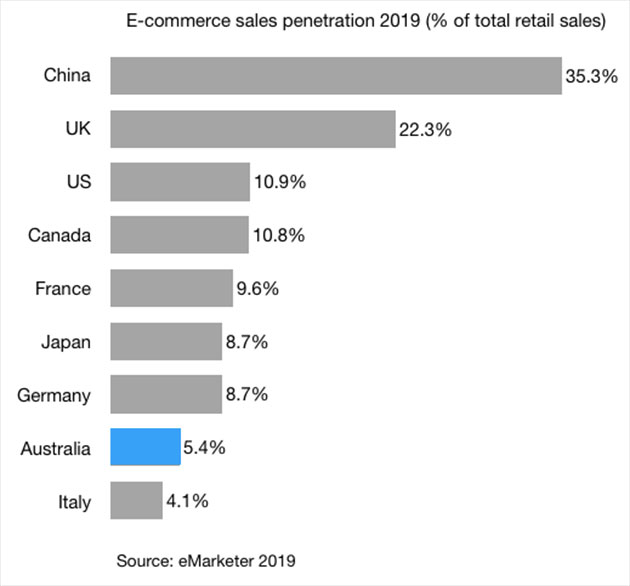Ecommerce Marketing Strategies and Online Shop Services
Online shopping and eCommerce keep on growing in all Europe at an amazing pace.
Even in the most mature countries like UK, Germany or Sweden, opportunities to increase online sales or start up with a new digital business are definitely real.
In the european b2c market online sales grow is remarkable and expected to hit 621 billion euros in 2019:

Number of companies starting up a new online shop is also booming as shown by eurostat e-commerce statistics, yet, given the online sales’ rate growth and the immense market targetable, also small-medium enterprises have the chance to launch a digital shop and support it with strategic eCommerce marketing campaigns.
Whether the eCommerce shop is already online or still to be launched there are some crucial aspects that have to be taking into account to plan a successful eCommerce internet marketing.
6 essential qualities for a successful eCommerce website
For any business or activity success results from a complex interplay of factors. Similarly, eCommerce websites’ success depends on many aspects. Setting apart the financial, logistic and industrial ones, the eCommerce digital marketing strategy is crucial since is the main instrument to promote services and market products online.
Ecommerce marketing lies on 6 main elements:
- Real and percepted value in relation to sale price;
- Website usability;
- Pleasant navigation and entertainment;
- Security and trust;
- Social media influence;
- Online marketing strategies.
1. Real and percepted value in relation to sale price
Otherwise than in the physical world, in internet comparing products features and prices is easy, immediate and zero cost: just a few click of mouse. In order to be competitive it is needed to shrink profit margins and, at the same time, communicate efficaciously the own added value and the advantages compared to other competitors. Meanwhile it is necessary to work on the identification of the right target consumers through online analysis and marketing after setting a clear goal: bringing to the website leads and prospects.
2. Website usability
Online shops remove human mediation from the purchasing process; for this reason it is paramount that it works perfectly and be easy to do. Purchase funnel, from products adding to cart to final payment, have to be short and require the minimum work. A good eCommerce website conforms to web usability guidelines and is accessible to everybody. It should be accessible to any type of device included smartphones and tablets (mobile website version).
3. Pleasant navigation and entertainment
A perfectly functional website may be highly inadequate in esthetic, ergonomic and communicational terms. If user experience is not pleasant and engaging finally sales are limited. The buying experience has always an emotional side that an eCommerce shop needs to include during the website planning and in the marketing strategies. Graphic and design should be likeable, information clear, contents interesting and, why not, entertaining.

4. Security and trust
In all eCommerce surveys and investigations customer’s perception of the buying process arises as a critical factor to increase online sales. A digital shop must reassure users by means of all possible signals. Security and trust are key concepts. Users ave to be able to contact the merchant by phone, email and possibly live chat. It is very important to offer transparency of shipping and delivery times, customer’s refund and return rights. Guarantee security of payments clearly showing methods and possibly credit cards logos. All details contribute to foster the conversion of visitors into clients/customers.
5. Social media influence
In our real life our purchases are influenced by opinions and suggestions coming from people we know, likewise on internet many sales occur only after reading recommendations and comments made by friends or unknown customers. An eCommerce website that integrates social networks and their sharing functions has certainly more chances to be successful. Similarly, conversion rate improves when a system to publish users opinions and reviews is added to products pages.
6. Digital marketing strategies
The previous five points somehow are all different aspects of an articulated eCommerce marketing strategy and should always be included in the digital marketing services provided to companies. More precisely, overall, they can be considered the backbone of the eCommerce marketing from which to develop specific tactics to promote the online shop. The amount of these tactics is endless, nonetheless a good plan should strive to coordinate them all to make eCommerce online marketing more effective.
Ecommerce online marketing
Without pretending to be exhaustive, a compendium of relevant eCommerce marketing strategies should include:
- Competitors analysis and prices benchmark;
- Website design and user experience improvement;
- SEM – Search Engine Marketing:
- SEO (Search Engine Optimization) and SMO (Social Media Optimization);
- SEA (Search Engine Advertising) and Social Network Advertising;
- Remarketing and Retargeting;
- Email marketing;
- Social Media Marketing:
- Conversational and Viral Marketing;
- Social media integration into the eCommerce website;
- Social login implementation;
- Content Marketing;
- Affiliate marketing;
- Marketplaces sales;
- Digital marketing across price comparison websites;
- Data mining and analysis.

In other website’s sections is possible to examine more in depth different types of online marketing; here we confine ourselves to list 27 advises very useful to increase e-Commerce sales.
1. Create the eCommerce website planning from the beginning at least part of the digital marketing strategy. Reflecting on marketing at this stage allows to better define features and functions that online shop is going to need.
2. Start search engine optimisation at the beginning of the eCommerce platform development.
3. Strive to specialise: big online shops are run by huge commercial entities.
4. Develop some unique product/service capable of giving popularity to you on the market. Promote it across all web channels.
5. Recuce profit margins of products in highly competitive markets: prices are a critical factor according to all e-Commerce studies.
6. Comply with delivery times especially in case of international eCommerce: making mistakes on this issue decrease significantly customers retention.
7. Allocate an adequate budget on SEO. All leads coming from organic search means money saved from different advertising investments.
8. Aim at the “long tail”. Most of website’s visits coming from organic searches are made of a variety of keywords and keyfrases of low occurrence.
9. There is not only Google. Leverage all search engines.
10. Use social networks to promote your brand and take advantage of word of mouth.

11. Be aware of your target, find out what it is told about you, monitor market sentiment and analyse your online reputation.
12. Launch a blog and produce valuable contents. All traffic generated by blog marketing reinforce brand reputation and impact positively on the eCommerce shop.
13. Take care of product sheets and use high quality photos.
14. Take on the challenge of product reviews: they boost sales and improve ranking on search engines.
15. Incentivise first purchase with a gift or enticing discount.
16. Leverage discounts, coupons and promotions to increase transactions.
17. Prepare bundles and gift packages, exploit cross and up selling to raise the average order value (AOV).
18. Push on email marketing which usually results in high conversion rates.
19. Incentivise in all ways newsletter sign-ups.
20. Chase users and customers with remarketing and retargeting campaigns.
21. Do not forget incentives for the purchase like scarcity and sense of urgency.
22. Facilitate impulse buying.
23. Exploit dynamic pricing technique. Products price is a critical aspect in online shopping. There are softwares that monitor prices on different eCommerce websites allowing an excellent benchmarking service in real time. The year Amazon has implemented this system profits raised a 27,2%. At Amazon online shop prices change every 10 minutes.
24. Invest on internet advertising and PPC campaigns knowing that each advertisment exposes your brand to a large audience, it is not just a strategy to generate leads.
25. Diminish as much as possible web pages loading time: it can make the difference.
26. Rely on website’s traffic statistics, analyse users’ behaviour and draw information to optimise digital marketing strategies.
27. Be opened to innovations, year by year internet gives birth to new marketing tools. Ecommerce websites must be the quickest to integrate them in their online strategy.
e-Commerce sales penetration in 2019 (main countries)

